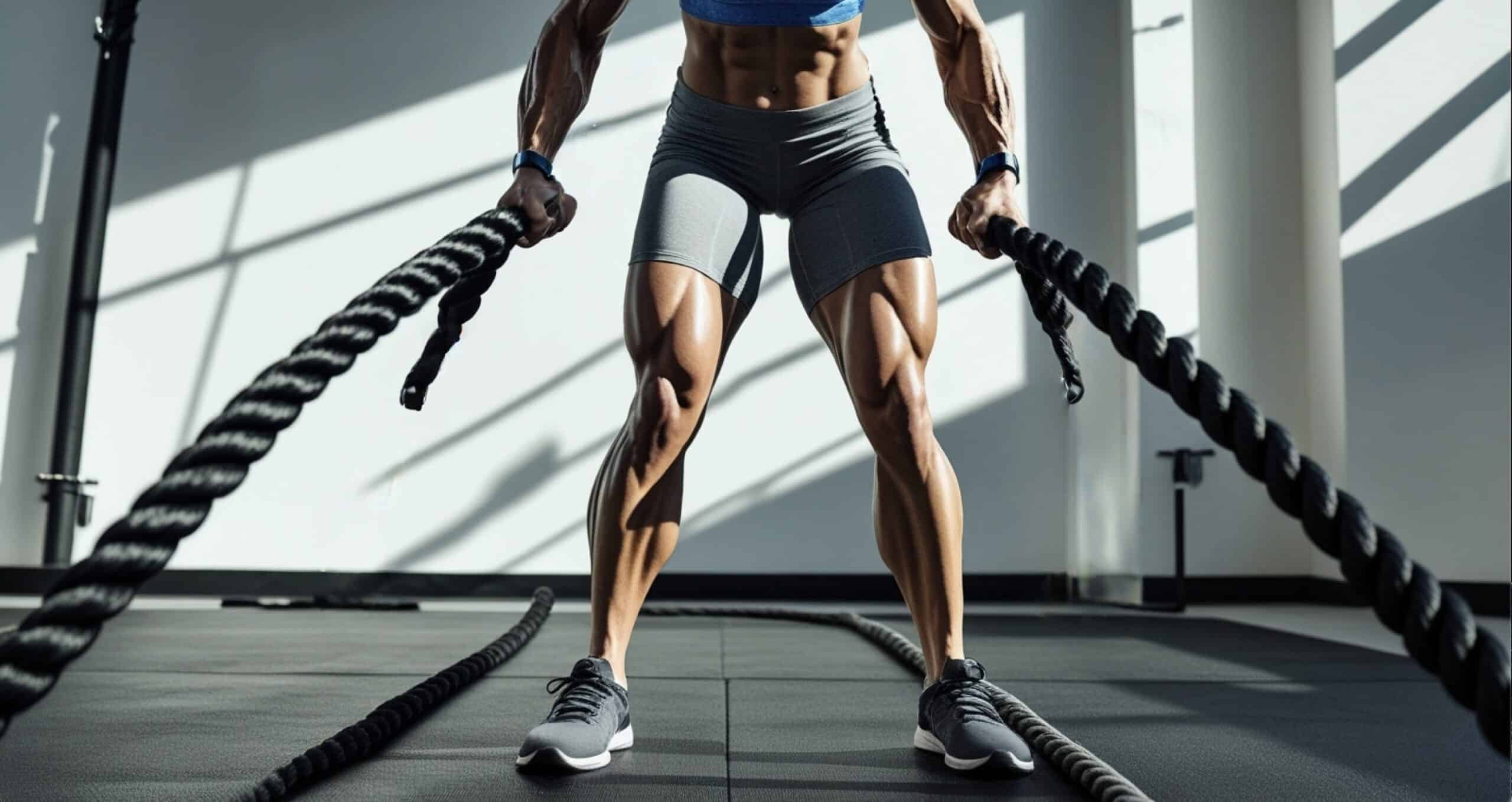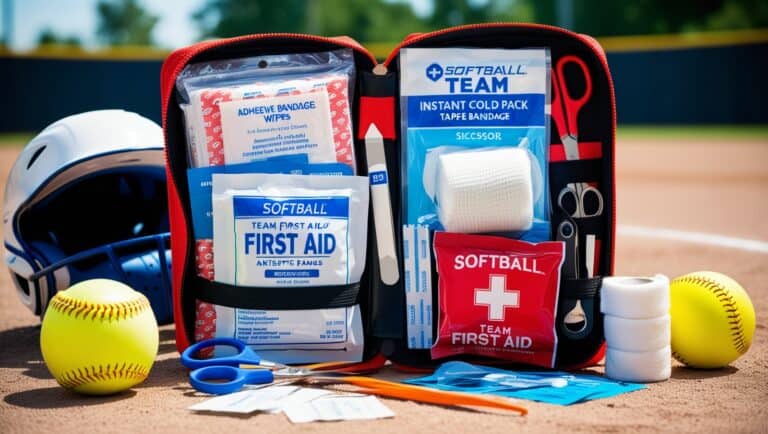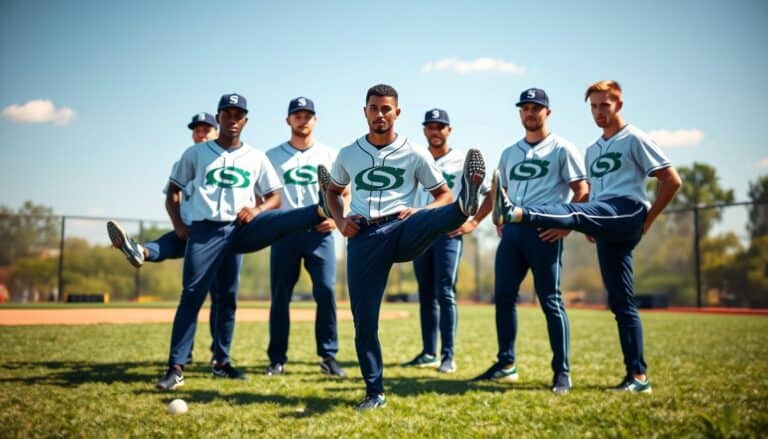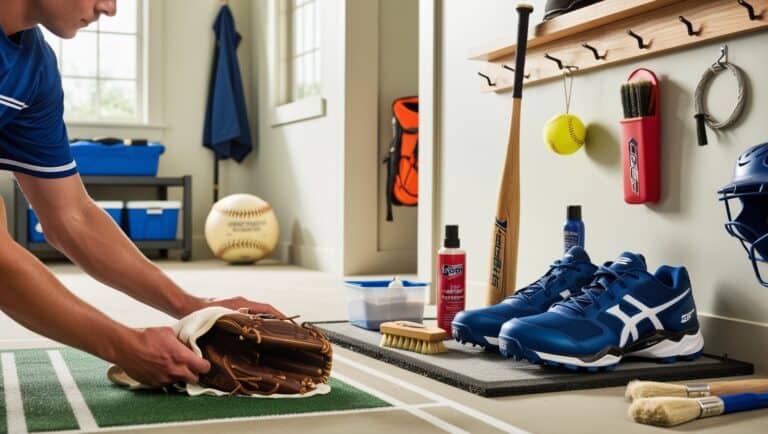Dynamic Cross-Training for Softball Exercises in 2025!

Hey there, softball superstars! Ready to take your game to the next level? Well, you’re in for a treat! It’s not just about practicing your swing or perfecting your pitch. Cross-training for softball is the secret weapon that’ll make you a force to be reckoned with. In this article, we’ll dive into 10 game-changing exercises that’ll have you dominating the diamond in no time. Let’s play ball!
Why Cross-Training is Essential for Softball Players
Let’s talk about cross-training, my friends! It’s not just a fancy word to throw around in the gym – it’s a game-changer for softball players. I’ve been coaching for years, and I can’t tell you how many times I’ve seen players transform their game by mixing things up off the field.
Cross-training is basically doing different types of exercises that complement your main sport. For softball players, it’s like giving your body a buffet of workouts instead of the same old meatloaf every day (no offense to meatloaf lovers). The beauty of cross-training for softball is that it helps you become a well-rounded athlete, not just a one-trick pony on the diamond.
Cross-training complements softball-specific skills in ways you might not expect. Take swimming, for instance. It builds incredible shoulder strength without the wear and tear of constant throwing. Or how about cycling? Great for leg power without the impact on your knees. These exercises translate to better performance on the field, whether you’re sprinting to first base or winding up to crush the ball in the gaps.
But here’s something else – cross-training isn’t just about getting better; it’s about staying in the game. I’ve seen too many players seasons get cut short by injuries. Cross-training helps prevent those nasty setbacks by strengthening the muscles you don’t typically use in softball. It’s like building a fortress for your body – the stronger and more balanced you are, the harder it is for injuries to break through.
Top 10 Cross-Training Exercises for Softball Success
Alright, let’s dive into the good stuff – the exercises that’ll take your softball game to the next level. I’ve put together a list of my top 10 cross-training exercises for softball players. These aren’t your run-of-the-mill workouts; they’re tailored specifically for the diamond.
- Burpees: Yeah, I know, everyone hates them, but they’re a full-body monster that’ll boost your explosiveness.
- Medicine Ball Rotational Throws: Perfect for mimicking that batting motion.
- Box Jumps: Great for improving your vertical leap for those high catches.
- Battle Ropes: Builds arm endurance for those long games.
- Kettlebell Swings: Fantastic for hip power, crucial for batting and pitching.
- TRX Rows: Strengthens your back for better throwing mechanics.
- Farmer’s Walks: Improves grip strength and overall body stability.
- Sled Pushes: Builds lower body power for sprinting bases.
- Bulgarian Split Squats: Great for single-leg strength and balance.
- Plank to Push-Up: Core stability and upper body strength in one move.
Now, I’m not saying you should ditch your softball practice for these exercises. The key is to incorporate them alongside your regular training. Think of it as adding secret ingredients to your already awesome recipe.
Each of these exercises translates directly to on-field performance. The beauty of these exercises is that they focus on functional movements – the kind of stuff your body actually does during a game. We’re not just building beach muscles here; we’re creating softball machines!
Strength Training: Building Power for the Diamond
Let’s talk about getting strong, really strong. Strength training is the unsung hero of softball success. You can transform from soft hitters into power hitters and weak throwers turn into rockets, all thanks to hitting the weights.
Now, I’m not talking about becoming a bodybuilder. We’re aiming for functional strength that translates to the field. The three key exercises of strength training for softball are squats, deadlifts, and bench presses. These compound movements work multiple muscle groups at once, giving you the most bang for your buck.
Squats are like the godfather of lower body exercises. They build explosive power in your legs and core, which is crucial for everything from sprinting to generating force in your swing.
Deadlifts are another game-changer. They work your entire posterior chain – that’s fancy talk for the backside of your body. This exercise is golden for developing the power needed for hitting and throwing. Plus, it’s great for your grip strength, which comes in handy when you’re trying to hold onto that line drive screaming at you.
Don’t forget about the upper body! Bench presses build chest and arm strength, which is key for throwing power. But here’s a tip: don’t just stick to the standard bench press. Mix in some incline and decline presses to hit different angles, just like you would when fielding or throwing from various positions.
Now, here’s where it gets fun. We can take these basic movements and add a softball twist. Try doing a squat with a medicine ball, then explosively standing up and throwing the ball. It’s like combining a squat with a throw – talk about specific training!
Remember, strength training isn’t about lifting the heaviest weights possible. It’s about consistent, progressive overload. Start with weights you can handle with good form, and gradually increase over time!
Agility and Speed: Improving Your Softball Footwork
Alright, let’s talk about getting quick on your feet. In softball, being fast isn’t just about straight-line speed – it’s about agility, quick changes of direction, and explosive movements. I’ve seen games won and lost based on a player’s ability to react quickly in the field or on the bases.
Ladder drills are a great example for this type of training. These drills improve your foot speed and coordination like nothing else. After a few weeks of ladder work, you will be snagging grounders that used to zip past you.
Cone exercises are another fantastic tool for building agility. Set up a series of cones in different patterns and practice sprinting, shuffling, and backpedaling between them. It’s like creating a mini-obstacle course that mimics the unpredictable movements you’ll need on the field.
Don’t forget about plyometrics! Box jumps, hurdle hops, and bounding exercises are great for developing explosive power. These exercises teach your muscles to contract quickly, which is exactly what you need when pushing off for a sprint or making a sudden change of direction.
Here’s a tip for enhancing your base running: practice your starts. Set up in a base-running position and explode into a sprint on a signal. Time yourself over short distances and try to improve your reaction time and initial burst of speed.
For fielding agility, I like to use a drill by having a partner randomly toss balls in different directions over your head, forcing you to react and change direction quickly to try and catch the ball. It’s challenging, but it’s also a lot of fun – and it directly translates to game situations.
Remember, agility isn’t just about being quick; it’s about being in control while you’re quick. Focus on maintaining good body position and balance throughout these drills. It might slow you down at first, but in the long run, it’ll make you a much more effective player.
Endurance Training: Lasting Through Extra Innings
Let’s chat about staying power – the kind that keeps you going strong when the game goes to seven innings or for tournament play. Endurance training for softball isn’t about running marathons; it’s about building the stamina to maintain peak performance throughout a long game or tournament.
Cardiovascular exercise is key, but we need to tailor it for softball. Long, slow jogs have their place, but they’re not going to cut it alone. Instead, focus on interval training that mimics the stop-and-start nature of the game. I recommend players do sprint intervals – 15 seconds all-out, followed by 30 seconds of jogging. It’s tough, but it works wonders for game-specific stamina. Pro-Tip: If you can’t do 15 seconds to start for sprinting you can start at 5 seconds and work your way up.
High-Intensity Interval Training (HIIT) is a game-changer for softball players. It not only improves your cardiovascular fitness but also helps with fat loss and muscle preservation. A simple HIIT workout could be something like this: 20 seconds of burpees, 10 seconds rest, 20 seconds of mountain climbers, 10 seconds rest, and so on for 4-5 rounds. Trust me, it’ll leave you gasping, but you’ll be happy when you’re still full of energy in the late innings.
Now, don’t get me wrong – building a strong aerobic base is important too. It helps with recovery between high-intensity bursts and improves your overall fitness. Try to incorporate some longer, steady-state cardio sessions into your routine. This could be a 30-minute jog, a bike ride, or even a swim if you have access to a pool.
Remember, endurance training isn’t just about lasting longer; it’s about maintaining the quality of your performance over time. It’s no good being able to play for hours if your skills deteriorate. So when you’re doing your endurance work, try to incorporate some skill elements too. For example, after a set of sprints, practice your throwing technique. It’ll teach your body to perform skills even when you’re tired.
Flexibility and Mobility: Enhancing Your Range of Motion
Alright, let’s stretch it out and talk about flexibility and mobility. Now, I know what you’re thinking – “Boring!” But trust me, this stuff is gold for softball players. It’s not just about touching your toes; it’s about improving your performance and keeping you in the game.
Yoga can be a secret weapon for softball players. It’s not just a fad and for soccer moms anymore! A good yoga routine can improve your flexibility, balance, and mental focus. It’s great for stress relief, which comes in handy during those high-pressure games. Especially if you go to one of those Yoga locations with heated Yoga classes. Man are those tough!!
Dynamic stretching is another key player in our flexibility lineup. Forget about doing just those old-school static stretches before a game. Dynamic stretches, like leg swings, arm circles, and torso twists, get your blood flowing and muscles ready for action. I always recommend teams do a dynamic warm-up before practices and games. It’s like oiling the machine before you start it up.
For batters, flexibility in the hips, torso, and shoulders is crucial for generating power in your swing. Think about it – your swing is essentially a coordinated whip action through your whole body. The more flexible you are, the more whip you can generate.
Fielders, you’re not off the hook either. Good flexibility and mobility mean you can get into those awkward positions to make tough plays look easy. It’s the difference between snagging that line drive and watching it sail over your outstretched glove.
But here’s the kicker – flexibility and mobility are also key players in injury prevention. Tight, inflexible muscles are more prone to strains and tears. By improving your range of motion, you’re essentially giving your body more wiggle room (literally) to handle the stresses of the game.
Core Stability: The Foundation of Softball Performance
Let’s get to the core of the matter – literally. Core stability is like the foundation of a house. Without it, everything else is shaky. In softball, a strong core is crucial for just about every movement you make on the field.
Now, when I say “core,” I don’t just mean abs. I’m talking about the whole midsection – front, sides, and back. This entire area acts as a bridge between your upper and lower body, transferring power and stabilizing your movements.
For pitchers, core strength is an absolute must. Your core is what allows you to maintain balance and control throughout your pitching motion. It’s also key in generating power.
Batters, your core is what allows you to rotate explosively during your swing. It’s the difference between a weak grounder and a line drive to the gap. A strong core helps you maintain your balance and posture throughout your swing, leading to more consistent contact.
And fielders, for you. A stable core is what allows you to make those quick, reactive movements to snag a hard-hit ball. It also helps in throwing, providing a stable base for your arm to generate power.
So, what kind of exercises am I talking about? Planks are a great start. But don’t just hold a static plank – try plank variations like plank jacks or mountain climbers. These add a dynamic element that’s more specific to softball movements.
Rotational exercises are key for softball players. Medicine ball rotational throws are one of my favorites. Stand sideways to a wall, hold a medicine ball at your chest, rotate away from the wall, then explosively rotate towards the wall and throw the ball. It’s like a batting motion without a bat. Note: Don’t do this at home, only in gyms in designated areas!
Russian twists, wood chops, and paloff presses are other great exercises for building rotational core strength. And don’t forget about good old-fashioned sit-ups and crunches – they still have their place in a well-rounded core routine.
Remember, core training isn’t about how many reps you can do. It’s about quality and control. I’d rather see 10 perfect reps than 50 sloppy ones. Focus on maintaining good form and really engaging your core throughout each movement.
Incorporate core work into your routine at least 2-3 times a week. You don’t need to spend hours on it – even 10-15 minutes of focused core work can make a big difference over time.
Cross-Training for Softball: Creating a Balanced Workout Plan
Alright, team, let’s put it all together and create a balanced cross-training plan for softball success. It’s like making the perfect sandwich – you need all the right ingredients in the right proportions.
First things first, you gotta find the right balance between softball practice and cross-training. I usually recommend 3-4 days of softball-specific training and 2-3 days of cross-training per week. But remember, this can vary based on your schedule, your current fitness level, and where you are in the season.
Here’s a sample weekly schedule:
- Monday: Softball practice + light cardio
- Tuesday: Strength training (focus on lower body) + core work
- Wednesday: Softball practice + agility drills
- Thursday: Upper body strength + HIIT cardio
- Friday: Softball practice + flexibility work
- Saturday: Full-body circuit training
- Sunday: Rest or light activity (like yoga)
Now, this is just a template. You’ll need to adjust based on your specific needs and schedule. Maybe you have games on weekends, so you’d shift your rest day. Or perhaps you need more work on your hitting, so you’d add extra batting practice.
It’s important to tailor your cross-training to your position too. Pitchers might focus more on shoulder stability and core work. Outfielders might emphasize speed and agility training. Infielders might prioritize quick reaction drills and lateral movement.
Don’t forget to periodize your training. This means changing the intensity and focus of your workouts throughout the year. In the off-season, you might focus more on building strength and endurance. As you get closer to the season, shift towards more power and speed work. During the season, maintain what you’ve built while focusing on recovery and injury prevention.
Listen to your body. If you’re feeling overly fatigued or notice a dip in performance, it might be time to dial back the intensity or take an extra rest day. Cross-training is supposed to enhance your softball performance, not detract from it.
Lastly, keep it fun! Mix things up to prevent boredom. Try a new yoga class, join a recreational basketball league, or challenge your teammates to a fitness competition. The more you enjoy your cross-training, the more likely you are to stick with it.
Whew! We’ve covered a lot of ground, haven’t we? From building strength to boosting agility, these cross-training exercises for softball are sure to take your game to new heights. Remember, consistency is key – so lace up those sneakers and get to work! Whether you’re a pitcher, batter, or fielder, incorporating these exercises into your routine will have you feeling like a pro in no time. So, what are you waiting for? Get out there and show the softball world what you’re made of! Play hard, train harder, and most importantly, have fun!
Craving more softball wisdom? Unlock game-changing tips below!






